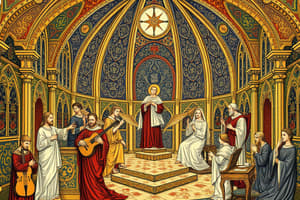Podcast
Questions and Answers
What is the time period of the Medieval music?
What is the time period of the Medieval music?
700 – 1400
Who influenced Europe's culture and political affairs during the Medieval Period?
Who influenced Europe's culture and political affairs during the Medieval Period?
- The Troubadours
- The Christian Church (correct)
- The Roman Empire
- The Renaissance artists
Gregorian Chant is a type of secular music.
Gregorian Chant is a type of secular music.
False (B)
What is the defining characteristic of Monophonic music?
What is the defining characteristic of Monophonic music?
Which of these is true about Troubadour Music?
Which of these is true about Troubadour Music?
Who was Adam de la Halle?
Who was Adam de la Halle?
What does the term 'Renaissance' mean?
What does the term 'Renaissance' mean?
What was the prominent instrument of the Renaissance era?
What was the prominent instrument of the Renaissance era?
Secular music became less significant during the Renaissance period.
Secular music became less significant during the Renaissance period.
What are the five sections of Mass music?
What are the five sections of Mass music?
Who is considered the greatest Roman Catholic Church musician of the Renaissance?
Who is considered the greatest Roman Catholic Church musician of the Renaissance?
Flashcards are hidden until you start studying
Study Notes
Music of Medieval Period (700 – 1400)
- Known as the Middle Ages or "Dark Ages," beginning with the fall of the Roman Empire.
- Christian Church played a significant role in shaping culture and political affairs in Europe.
Sacred Music
- Defined as music specifically composed for religious services.
- Pope Gregory I associated with the development of Gregorian Chant.
- Monophonic Plainchant was the dominant form, introduced as oral traditions later notated for wider dissemination across Europe.
Characteristics of Gregorian Chant
- Monophonic texture, allowing for a single melodic line.
- Free meter, not constrained by the regular rhythms of later musical forms.
- Mode-based, utilizing various modes rather than a fixed scale.
- Typically based on Latin liturgical texts.
- Employed Neume notation to indicate pitch movement.
Secular Music
- Composed for non-religious purposes, often expressing themes outside of spirituality.
- Troubadours, musicians of medieval France, were known for performing this genre.
Characteristics of Troubadour Music
- Usually monophonic, sometimes with improvised accompaniment.
- Focused on themes of chivalry and courtly love.
- Lyrics predominantly written in the French language.
Notable Composer of the Medieval Period
- Adam de la Halle (1237 - 1288), also known as Adam the Hunchback.
- Born in France and linked to notable patrons like Robert II and Charles of Anjou.
- Initially destined for church service, but later married, indicating a blend of secular influences in his compositions.
- Recognized as one of the earliest secular composers in this era.
Music of Renaissance Period (1400 – 1600)
- Renaissance translates to "Rebirth," reflecting a renewed interest in the classical arts and ancient cultures.
- This period is often referred to as the Golden Age of a cappella music.
Innovations and Influences
- The printing press invention in the 1400s allowed for broader distribution of compositions.
- Growth of the bourgeois class contributed to music becoming a popular pastime for educated amateurs.
- The lute emerged as a prominent instrument during this era, while the influence of the Roman Catholic Church began to decline, leading to an increase in secular music.
Characteristics of Renaissance Music
- Predominantly polyphonic, featuring multiple independent melody lines.
- Imitation between voices is common, creating a rich texture.
- Use of word painting, where the music reflects the text's meaning.
- Melodic lines flow smoothly with fewer large leaps, making them more accessible for performers.
Vocal Music Forms in the Renaissance
-
Mass Music: Sacred compositions setting Eucharistic texts to music.
- Characterized by polyphony and can be a cappella or orchestral.
- Text can be syllabic, neumatic, or melismatic.
-
Sections of Mass Music:
- Kyrie: "Lord Have Mercy"
- Gloria: "Glory to God in the highest"
- Credo: Apostles/Nicaean Creed
- Sanctus and Benedictus: "Holy, Holy" / "Blessed is He"
- Agnus Dei: "Lamb of God"
-
Madrigal: Secular vocal polyphonic music, originated in Italy, often sung at social gatherings.
- Characteristics include polyphony, a cappella performance, and frequent use of 3-6 voices.
Notable Composers of the Renaissance Period
-
Giovanni Pierluigi de Palestrina (1525 – 1594):
- Renowned as the greatest Roman Catholic church musician.
- Known for his majority focus on sacred music and compositions reflecting the Counter-Reformation style.
-
Thomas Morley (1557 – 1602):
- An accomplished singer from Norwich, England, who contributed significantly to the Renaissance vocal music repertoire.
Studying That Suits You
Use AI to generate personalized quizzes and flashcards to suit your learning preferences.




